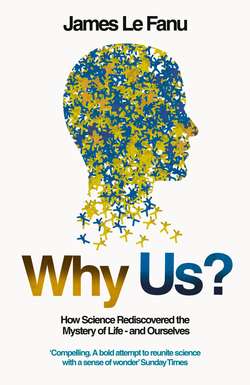Читать книгу Why Us?: How Science Rediscovered the Mystery of Ourselves - James Fanu Le - Страница 8
The Double Helix
ОглавлениеThe Double Helix, discovered by James Watson and Francis Crick in 1953, is among the most familiar images of twentieth-century science. Its simple and elegant spiral structure of two intertwined strands unzips and replicates itself every time the cell divides – each strand, an immensely long sequence of just four molecules (best conceived, for the moment, as four different-coloured discs – blue, yellow, red and green). The specific arrangement of a thousand or more of these coloured discs constitutes a ‘gene’, passed down from generation to generation, that determines your size and shape, the colour of your eyes or hair or any other similarly distinguishing traits, along with the thousands of widgets or parts from which we are all made. It would take another fifteen years to work it all out, at least in theory – but the practical details of which particular sequence of coloured discs constituted which gene, and what each gene did, still remained quite unknown. This situation would change dramatically in the 1970s, with three technical innovations that would allow biologists first to chop up those three billion ‘coloured discs’ into manageable fragments, then to generate thousands of copies the better to study them, and finally to ‘spell out’ the sequence (red, green, blue, green, yellow, etc., etc.) that constitutes a single gene.
It lies beyond hyperbole to even try to convey the excitement and exhilaration generated by this trio of technical innovations, whose potential marked ‘so significant a departure from that which had gone before’ they would become known collectively as ‘the New Genetics’. The prospect of deciphering the genetic instructions of ‘life’ opened up a Pandora’s box of possibilities, conferring on biologists the opportunity to change the previously immutable laws of nature by genetically modifying plants and animals. The findings of the New Genetics filled the pages not only of learned journals but of the popular press: ‘Gene Find Gives Insight into Brittle Bones’, ‘Scientists Find Genes to Combat Cancer’, ‘Scientists Find Secret of Ageing’, ‘Gene Therapy Offers Hope to Victims of Arthritis’, ‘Cell Growth Gene Offers Prospect of Cancer Cure’, ‘Gene Transplants to Fight Anaemia’, and so on.
The New Genetics, in short, swept all before it to become synonymous with biology itself. Before long the entire spectrum of research scientists – botanists, zoologists, physiologists, microbiologists – would be applying its techniques to their speciality. The procedures themselves in turn became ever more sophisticated, opening up the prospect that the New Genetics might transcend the possibilities of discovering ‘the gene for this and the gene for that’, to spell out the entire sequence of coloured discs strung along the Double Helix and thus reveal the full complement of genes, known as The Genome. There was every reason to suppose that deciphering the full set of genetic instructions of what makes a bacterium a bacterium, a worm a worm, and a common housefly a common housefly would reveal how they are made and how they come to be so readily distinguishable from each other – why the worm should burrow and the fly should fly. Then, at the close of the 1980s, the co-discoverer of the Double Helix, James Watson, proposed what would become the single most ambitious and costly project ever conceived in the history of biology – to spell out the full complement of human genes. Thus the Human Genome Project (HGP) was born, with its promise to make clear what it is in our genes that makes us, ‘us’. The truism that ‘the answer lies in the genes’ is not merely an abstract idea, rather the set of instructions passed down from generation to generation influences every aspect of our being: our physical characteristics, personality, intelligence, predisposition to alcoholism or heart disease, and much else besides. Spell out the human genome in its entirety, and all these phenomena, and more, should finally be accounted for.
‘The search for this “Holy Grail” of who we are,’ observed Harvard University’s Walter Gilbert, ‘has now reached its culminating phase, the ultimate goal is the acquisition of all the details of our genome … that will transform our capacity to predict what we will become.’ There could be no greater aspiration than to ‘permit a living creature’, as Robert Sinsheimer, Chancellor of the University of California, put it, ‘for the first time in all time, to understand its origins and design its future’. The Genome Project would, claimed Professor John Savile of Nottingham’s University Hospital, ‘like a mechanical army, systematically destroy ignorance’, while ‘promising unprecedented opportunities for science and medicine’.
The Human Genome Project was formally launched in 1991, with a projected cost of $3 billion over the fifteen years it was expected it would run. The task of assembling the vast quantity of data generated by spelling out the human genome was divided across several centres, most of them in the United States, Britain and Japan. The scene within those ‘genomes centres’ could have come from a science fiction film – gleaming automated machines as far as the eye could see, labelling each chemical of the Double Helix with its own fluorescent dye which was then ‘excited’ by a laser and the results fed directly into a computer. ‘The Future is Now’ trumpeted the cover of Time magazine, imposing that iconic image of the Double Helix over the shadowy outline of a human figure in the background.
